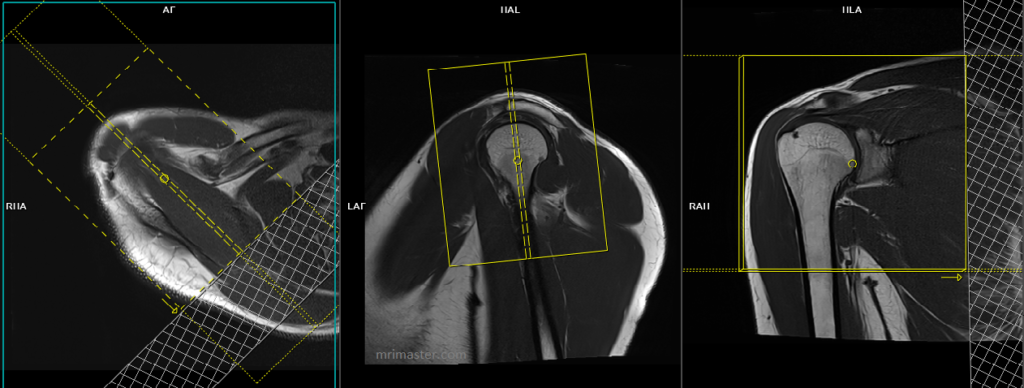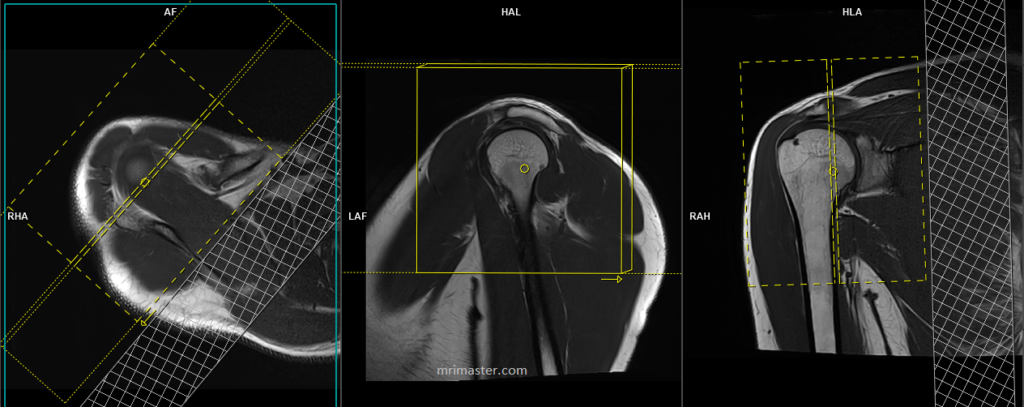MRI Shoulder
Indications for shoulder MRI scan
- Marrow abnormalities (e.g. bone contusions, osteonecrosis, marrow edema syndromes, and stress fractures)
- Synovial based disorders ( e.g. synovitis, tenosynovitis, bursitis, and ganglion cysts)
- Infections of bone, joint, or soft tissue (e.g. osteomyelitis, osteochondritis, osteoarthritis )
- Evaluation of suspected cartilaginous defects
- Evaluation of intra-articular loose bodies
- Neoplasms of bone, joint, or soft tissue
- Avascular necrosis
- Nerve Impingement
- Fractures in children
- Soft tissue masses
- Occult fracture
- Ligament tear
Contraindications
- Any electrically, magnetically or mechanically activated implant (e.g. cardiac pacemaker, insulin pump biostimulator, neurostimulator, cochlear implant, and hearing aids)
- Intracranial aneurysm clips (unless made of titanium)
- Pregnancy (risk vs benefit ratio to be assessed)
- Ferromagnetic surgical clips or staples
- Metallic foreign body in the eye
- Metal shrapnel or bullet
Patient preparation for shoulder MRI
- A satisfactory written consent form must be taken from the patient before entering the scanner room
- Ask the patient to remove all metal objects including keys, coins, wallet, cards with magnetic strips, jewellery, hearing aid and hairpins
- If possible provide a chaperone for claustrophobic patients (e.g. relative or staff )
- Offer earplugs or headphones, possibly with music for extra comfort
- Explain the procedure to the patient
- Instruct the patient to keep still
- Note the weight of the patient
Positioning for shoulder MRI
- Position the patient in supine position with head pointing towards the magnet (head first supine)
- Position the shoulder in the Shoulder coil or and immobilize with sand bags
- Centre the laser beam localiser over the shoulder joint or the mid line of the coil
- Register the patient on the scanner as 'head first supine'

Recommended MRI Shoulder Protocols, Parameters, and Planning
Shoulder localiser
A three-plane localizer must be taken at the beginning to localize and plan the sequences. Typically, localizers take less than 25 seconds and utilize T1 weighted low-resolution scans for this purpose. It is advisable to acquire additional localizers based on the initial localizer to obtain accurate coronal, axial, and sagittal views of the shoulder.

T2* medic or PD fat sat axial 3mm SFOV
Plan the axial slices on the coronal plane and angle the positioning block perpendicular to the glenohumeral joint. Check the positioning block in the other two planes. Use an appropriate angle in the sagittal plane, perpendicular to the humeral head. The slices should be sufficient to cover the entire shoulder joint from the top of the acromioclavicular joint to two slices below the inferior glenohumeral ligament (articular capsule). Adding saturation bands over the chest will help reduce ghosting artifacts caused by breathing. The phase direction should be anteroposterior to avoid wrap-around and ghosting artifacts from the chest.

Parameters pd fs
TR 3500-4500 | TE 30-40 | SLICE 3 MM | FAT SAT SPAIR | PHASE A>P | MATRIX 320X320 | FOV 150-160 | GAP 10% | NEX(AVRAGE) 2 |
Parameters medic
TR 1000-1200 | TE 30 | SLICE 3 MM | FLIP 40 | PHASE A>P | MATRIX 320X256 | FOV 150-180 | GAP 10% | NEX(AVRAGE) 2 |
T1 tse coronal 3mm SFOV
Plan the coronal slices on the axial plane and angle the positioning block parallel to the supraspinatus tendon. Do not exceed a 45° angle, as angling more than 45° will result in a change from the coronal plane to the sagittal plane. Verify the positioning block’s alignment in the other two planes. Use an appropriate angle in the sagittal plane, parallel to the humeral head. Ensure that the slices cover the entire shoulder joint, extending from the anterior portion of the coracoid process to two slices posterior to the humeral head. Additionally, consider adding an oblique saturation band over the chest to minimize ghosting artifacts caused by breathing.

Parameters
TR 400-600 | TE 15-25 | SLICE 3 MM | FLIP 130 | PHASE A>P | MATRIX 320X320 | FOV 150-180 | GAP 10% | NEX(AVRAGE) 2 |
T2* medic or PD fat sat coronal 3mm SFOV
Plan the coronal slices on the axial plane and angle the positioning block parallel to the supraspinatus tendon. Do not exceed a 45° angle, as angling more than 45° will result in a change from the coronal plane to the sagittal plane. Verify the positioning block’s alignment in the other two planes. Use an appropriate angle in the sagittal plane, parallel to the humeral head. Ensure that the slices cover the entire shoulder joint, extending from the anterior portion of the coracoid process to two slices posterior to the humeral head. Additionally, consider adding an oblique saturation band over the chest to minimize ghosting artifacts caused by breathing.

Parameters pd fs
TR 3000-4000 | TE 30-40 | SLICE 3 MM | FAT SAT SPAIR | PHASE A>P | MATRIX 320X320 | FOV 150-160 | GAP 10% | NEX(AVRAGE) 2 |
Parameters medic
TR 1000-1200 | TE 30 | SLICE 3 MM | FLIP 40 | PHASE R>L | MATRIX 320X256 | FOV 150-160 | GAP 10% | NEX(AVRAGE) 2 |
T2 stir coronal 3mm SFOV
Plan the coronal slices on the axial plane and angle the positioning block parallel to the supraspinatus tendon. Do not exceed a 45° angle, as angling more than 45° will result in a change from the coronal plane to the sagittal plane. Verify the positioning block’s alignment in the other two planes. Use an appropriate angle in the sagittal plane, parallel to the humeral head. Ensure that the slices cover the entire shoulder joint, extending from the anterior portion of the coracoid process to two slices posterior to the humeral head. Additionally, consider adding an oblique saturation band over the chest to minimize ghosting artifacts caused by breathing.

Parameters
TR 3000-4000 | TE 110 | FLIP 130 | NEX 2 | SLICE 3MM | MATRIX 320X256 | FOV 150-160 | PHASE H>F | GAP 10% | TI 130 |
PD fat sat sagittal 3mm SFOV
Plan the sagittal slices on the axial plane and angle the positioning block perpendicular to the supraspinatus tendon. Verify the positioning block in the other two planes. Ensure an appropriate angle is set in the coronal plane, parallel to the humerus. Include enough slices to cover the entire shoulder joint, from the deltoid muscle to the scapular notch. Additionally, consider adding an oblique saturation band over the chest to minimize ghosting artifacts caused by breathing.

Parameters PD FS
TR 3000-4000 | TE 30-40 | SLICE 3 MM | FAT SAT SPAIR | PHASE A>P | MATRIX 320X320 | FOV 150-160 | GAP 10% | NEX(AVRAGE) 2 |


